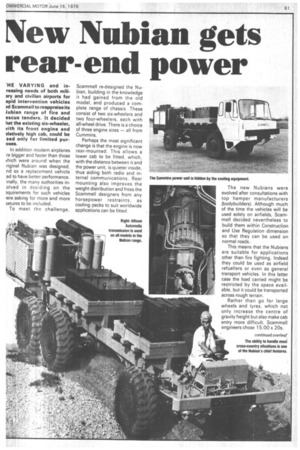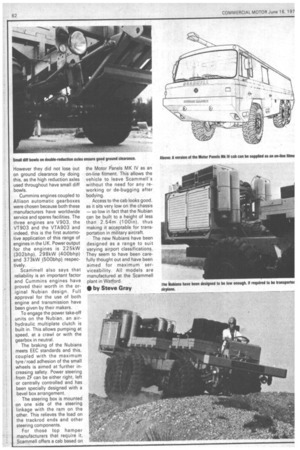New Nubian gets rear-end power
Page 63

Page 64

If you've noticed an error in this article please click here to report it so we can fix it.
'HE VARYING and inTeasing needs of both minary and civilian airports for apid intervention vehicles
Scammell to reappraise its lubian range of fire and escue tenders. It decided hat the existing six-wheeler, with its front engine and elatively high cab, could be sed only for limited pur-. oses In addition modern airplanes re bigger and faster than those ithich were around when the figinal Nubian was designed, nd so a replacement vehicle ad to have better performance. inally, the many authorities inolved in deciding on the aquirernents for such vehicles /ere asking for more and more 3atures to be included,
To meet the challenge, Scammell re-designed the Nubian, building in the knowledge it had gained from the old model, and produced a complete range of chassis. These consist of two six-wheelers and two four-wheelers, each with all-wheel drive. There is a choice of three engine sizes — all from Cummins, Perhaps the most significant change is that the engine is now rear-mounted. This allows a lower cab to be fitted, which, with the distance between it and the power unit, is quieter inside, thus aiding both radio and internal communications. Rear mounting also improves the weight distribution and frees the Scammell designers from any horsepower restraints, as cooling packs to suit worldwide applications can be fitted The new Nubians were evolved after consultations with top hamper manufacturers (bodybuilders). Although much of the time the vehicles will be used solely on airfields, Scammeil decided nevertheless to build them within Construction and Use Regulation dimension so that they can be used on normal roads..
This means that the Nubians are suitable for applications other than fire fighting. Indeed they could be used as airfield refuellers or even as general transport vehicles. In this latter case the load carried might be restricted by the space available, but it could be transported across rough terrain.
Rather than go for large wheels and tyres, which not only increase the centre of gravity height but also make cab entry more difficult, Scammell engineers chose 15.00 x 20s. However they did not lose Out on ground clearance by doing this, as the high reduction axles used throughout have small diff bowls.
Cummins engines coupled to Allison automatic gearboxes were chosen because both these manufacturers have worldwide service and spares facilities. The three engines are V903, the VT903 and the VTA903 and indeed, this is the first automotive application of this range of engines in the UK. Power output for the engines is 225kW (302bhp), 298kW (400bhp) and 373kW ,(500bhp) respec tively. _ Scammell also says that reliability is an important factor and Cummins engines have proved their worth in the original Nubian design. Full approval for the use of both engine and transmission have been given by their makers.
To engage the power take-off units on the Nubian, an airhydraulic multiplate clutch is built in. This allows pumping at speed, at a crawl or with the gearbox in neutral.
The braking of the Nubians meets EEC standards and this, coupled with the maximum tyre/road adhesion of the small wheels is aimed at further increasing safety. Power steering from ZF can be either right, left or centrally controlled and has been specially designed with a bevel box arrangement.
The steering box is mounted on one side of the steering linkage with the ram on the other. This relieves the load on the trackrod ends and other steering components.
For those top hamper manufacturers that require it, Scammell offers a cab based on
the Motor Panels MK IV as an on-line fitment. This allows the vehicle to leave Scammell's without the need for any reworking or de-bugging after. bodying.
Access to the cab looks good, as it sits very low on the chassis — so low in fact that the Nubian can be built to a height of less than 2.54m (100in), thus making it acceptable for transportation in military aircraft.
The new Nubians have been designed as a range to suit varying airport classifications. They seem to have been carefully thought out and have been aimed for maximum serviceability. All models are manufactured at the Scammell plant in Watford. .
• by Steve Gray
















































































































